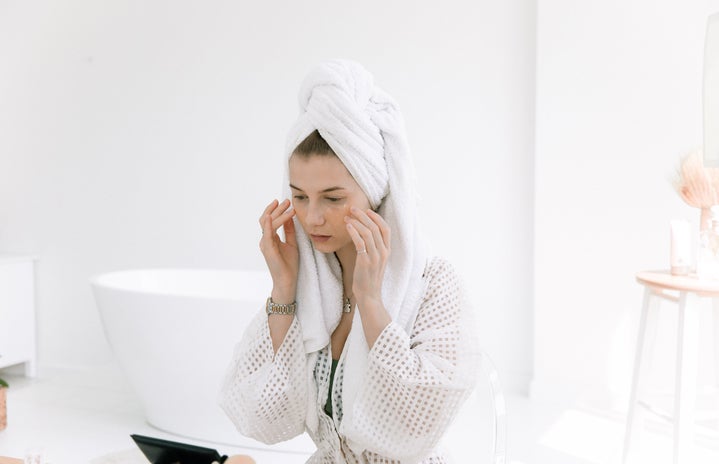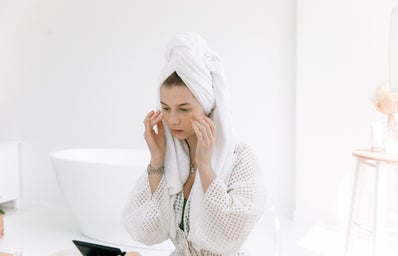Walk into any local Shoppers Drug Mart or Sephora and skim the shelves; you’ll likely notice beautifully white and green packaged products, shiny lids gleaming under the yellow-hued light of the store and beautiful marketing schemes as far as the eye can see. Claims like ‘renewed appearance’ or ‘sulfate-free’ are stamped onto a large majority of bottles, with promises of ‘cruelty-free’ and ‘paraben-free’, checking off many important boxes for skincare fanatics worldwide. These claims are underwhelming in the broadest sense, and between you and I, should be taken lightly. Why?
Clean beauty is typically associated with green beauty, anything that deviates from the norm of chemically-based beauty products. However, there isn’t a true definition for clean beauty. What the brand deems as ‘clean’ is often up to them, although there are some criteria that must be met.
The beauty products must be made with ingredients that aren’t considered harmful (usually natural and synthetic), however there can be a lot of misconceptions with how many brands are actually clean and how many are just greenwashing consumers.
Sephora’s Clean Stamp & Greenwashing 101
Back in 2018, Sephora launched the “Clean at Sephora Initiative”, their tagline being ‘The beauty you want, minus the ingredients you may not.’ Any product that received the clean stamp on the side of their bottle was promised to only contain products that are free of more than 50 questionable ingredients, such as parabens, mineral oils, formaldehyde and many more. Brands like Drunk Elephant, Farmacy and Youth to the People separate clean from bad in numerous products, all rightfully earning the minimalist green stamp. Sephora had tried to launch a line of clean skincare before but an article by Mindbodygreen.com suggests that their clientele wasn’t ready for clean products just yet. Not until the Wellness industry grew, that is. Since 2015, the Wellness economy has grown by 6.4% annually, which doubles what the global economy has grown.
Although some consumers bought into this marketing ploy, others were quick to realize that just because they’re considered ‘clean’ products doesn’t make them better than their traditional counterpart. According to an article by Reuters.com, wellness and lifestyle blogs have expertly instilled fear in the minds of many, making them think twice before swiping their card, even on products they’d sworn by their whole life.
Before you buy:
So how do you distinguish a Greenwashed brand from the rest? It’s easy.
-
Look for and beware of fluffy terms, the kind that appeal to a consumer’s goodwill without clearly expressing the ingredients in the product.
-
Check the ingredients – This one is pretty simple, but don’t let the packaging fool you. Look for ingredients like these. This short list is said to have a lasting impact on your health, even by using just a small amount.
-
Note that currently, the FDA does NOT have a certified definition for what is considered as ‘organic’ beauty. A product can be marketed as organic, yet only have one or two ingredients in it that are organic, while all of the others might be harmful.
The debate
Many have become increasingly concerned with the environment, which leads them to think twice before applying products to their skin. Especially if they don’t know what’s in it. Student Rachel Parent avoids toxic substances at all costs. “I use primarily natural products as I find synthetic products too harsh on my skin. I also look for cruelty-free/vegan products because beyond animal testing, many products have nasty ingredients.” Parent uses the example of squalene, derived from shark liver, and how that is definitely not something she wants to apply to her face.
However, just because these so-called ‘clean’ products work for some doesn’t necessarily mean they work for others. Another student, Lexia Khan feels as though she doesn’t get the most bang for her buck, feeling dissatisfied with many of the products she’s tried. “I tried using [natural] skincare products for a few months to help with my acne and overall complexion. Unfortunately, it was a complete money grab. It was only when I switched to products that include ingredients like salicylic acid that I finally got rid of my acne.”
Skincare & Lifestyle Blogger, Maria McCollum feels that it’s extremely important to know what you’re putting on your skin. “I think that brands in the skincare industry are capitalizing on the popularity of the ‘fresh and clean’ movement. Besides noticing an increase in fear-mongering, I’ve also noticed that the [clean skincare] movement is invalidating one brand from another, not taking into account that different people’s skin reacts differently.” Although McCollum would rather use real ingredients on her face, she doesn’t appreciate the divide between ‘clean and not-clean’ and believes that trial and error is the best way to see what works well for you.
*Check her out @glow_by_maria on Instagram!
The COVID-19 pandemic and what that means for skincare
Ever since the COVID-19 pandemic began a year ago when mask-wearing and working from home came into place, a study shows that makeup sales have been way down due to the fact that there’s nowhere to go, meaning there’s less of a need to get ready on a day-to-day basis. Sales on self-care products have been growing exponentially, however, making skin-care one of the more resilient beauty categories over the past year. More than 1/3 of women have expanded their skincare line since the beginning of the pandemic, which is no surprise. Not only that, but influencers have taken it upon themselves to rave about skincare products from the comfort of their own homes, then uploading their reviews onto social media sites, like Instagram and Tik Tok, in hopes of making trends out of new serums and eucalyptus showers.
Studies show the trend of wearing less makeup is likely to continue even post-pandemic. What does that mean? Well, it’s like matching lounge sets & fun face masks are in, while blazers, button-downs and eyeshadow palettes are out. People have become more conscious with ensuring their wellness, and what better way to do that than investing in feel-good products? As placebo as that might sound, I’m just as guilty of it.
A final word
Brand accountability is reputable, especially in skin care. Buyers deserve to be sure of what products they’re investing in, toxic or not. However, the choice should also be theirs in the sense that they shouldn’t be shamed for purchasing products they know will work for them. In the end, whatever makes you feel your most comfortable and confident is definitely a product worth investing in. Regardless, be mindful of the products and do your research before fully committing, ‘clean’ or not. Your skin will most definitely thank you, I’m almost sure of it.



